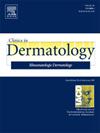Ultrasonographic features of nonvascular complications of hyaluronic acid fillers: a retrospective study at a reference center for dermatologic ultrasonography
IF 2.3
4区 医学
Q2 DERMATOLOGY
引用次数: 0
Abstract
Hyaluronic acid filler injections have been associated with early, temporary, and delayed-onset complications. High-resolution ultrasound with Doppler analysis has been increasingly used to detect and identify such complications. We comprehensively describe the most common ultrasonographic findings of nonvascular complications associated with hyaluronic acid filler injections. This retrospective, cross-sectional, observational study was conducted at a reference center for dermatologic ultrasound in Bogotá, Colombia. Ultrasound reports documented the ultrasonographic findings of nonvascular complications of hyaluronic acid filler injections. Fifty-two complications were documented in a cohort of 50 patients (women, 88%). The infraorbital region was the most common site affected (23%), followed by the nasolabial region (22%). The Tyndall effect was the most common complication (25% of all), followed by changes in rheology (21%) and pseudosarcoidal (foreign body granuloma) reaction (15%). The Tyndall effect stood out for its distinctive ultrasonographic characteristics. We discuss the ultrasonographic findings and pathogenesis of other complications, including filler migration, early hypersensitivity, aseptic abscess, overcorrection, and filler material interaction. The clinical presentation of hyaluronic acid filler complications can be confusing, delaying timely diagnosis and treatment. High-resolution ultrasound with Doppler analysis is a valuable tool for avoiding unnecessary treatments and ensuring timely diagnosis and treatment.
透明质酸填充剂非血管并发症的超声波特征:皮肤科超声波参考中心的回顾性研究。
透明质酸(H.A.)填充剂注射与早期、暂时和延迟发病的并发症有关。带有多普勒分析的高分辨率超声波(HRUS)越来越多地被用于检测和识别此类并发症。我们全面描述了与注射 H.A. 填充剂相关的非血管并发症中最常见的超声波检查结果。这项回顾性横断面观察研究是在哥伦比亚波哥大的一家皮肤科超声参考中心进行的。超声波报告记录了注射 H.A. 填充剂后非血管并发症的超声波检查结果。在 50 名患者(女性占 88%)中,共记录了 52 例并发症。眶下区域是最常见的受影响部位(23%),其次是鼻唇部(22%)。廷德尔效应是最常见的并发症(占 25%),其次是流变学变化(21%)和假性肉芽肿(异物肉芽肿)反应(15%)。廷德尔效应因其独特的超声造影特征而引人注目。我们讨论了其他并发症的超声波检查结果和发病机制,包括填充物迁移、早期过敏、无菌性脓肿、过度矫正和填充材料相互作用。H.A.填充并发症的临床表现可能令人困惑,从而延误及时的诊断和治疗。带有多普勒分析的 HRUS 是避免不必要治疗、确保及时诊断和治疗的重要工具。
本文章由计算机程序翻译,如有差异,请以英文原文为准。
求助全文
约1分钟内获得全文
求助全文
来源期刊

Clinics in dermatology
医学-皮肤病学
CiteScore
4.60
自引率
7.40%
发文量
106
审稿时长
3 days
期刊介绍:
Clinics in Dermatology brings you the most practical and comprehensive information on the treatment and care of skin disorders. Each issue features a Guest Editor and is devoted to a single timely topic relating to clinical dermatology.
Clinics in Dermatology provides information that is...
• Clinically oriented -- from evaluation to treatment, Clinics in Dermatology covers what is most relevant to you in your practice.
• Authoritative -- world-renowned experts in the field assure the high-quality and currency of each issue by reporting on their areas of expertise.
• Well-illustrated -- each issue is complete with photos, drawings and diagrams to illustrate points and demonstrate techniques.
 求助内容:
求助内容: 应助结果提醒方式:
应助结果提醒方式:


